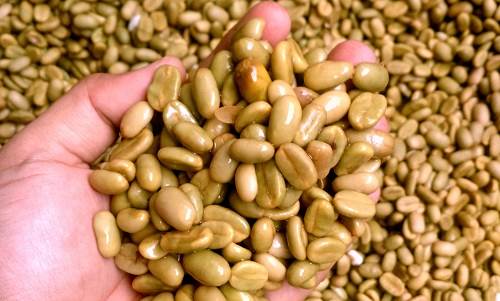
The millennial generation is definitely very familiar with coffee. Coffee is a refreshing drink. Why is it called a refreshing drink, because there are effects that are felt after drinking it. A cup of coffee can improve the functioning of the nervous system so that it can increase concentration and eliminate drowsiness. Consuming the right portions will provide benefits for body fitness. The movement of the coffee-based creative economy is already visible all around us. Coffee shops are mushrooming everywhere, not only in Indonesia but also abroad. This is indicated by world demand for coffee increasing from year to year. Did you also know that coffee is a strategic agricultural commodity for Indonesia? Based on data from the International Coffee Organization (2022), Indonesia is the world's number two coffee exporting country after Brazil in 2017-2021. Coffee exports increased by 1.7 percent from 2020 to 2021. Indonesian coffee exports reached USD 620.41 million, 58 percent of coffee exports were unprocessed rice coffee. Indonesian coffee production in 2020 reached 12,100 bags 60 kg, from 2019 to 2020 there was an increase in production of 5.8 percent. (https://www.ico.org/prices/po-production.pdf). Based on data from the Ministry of Agriculture (2020), Indonesia's coffee production is 760.96 thousand tons, of which 72.66 percent or 531.56 thousand tons is robusta coffee. Meanwhile, the remaining 27.34 percent or 200.06 thousand tons is Arabica coffee.
The majority of coffee plantations are operated by the people, namely 95.45 percent and the rest is operated by the state and private sector. Robusta coffee production centers in Indonesia, based on average data for the last five years, are the provinces of South Sumatra, Lampung, Bengkulu, East Java and Central Java. The Arabica coffee production centers in the same year were in the provinces of Aceh, North Sumatra, South Sulawesi, West Sumatra and West Java (Ministry of Agriculture Coffee Outlook, 2020). Coffee that can penetrate the export market is coffee that has good quality. Coffee quality based on the Indonesian National Standard (SNI) 01-2907-2008 is measured based on physical characteristics. Namely the size of the beans, the appearance of the coffee beans including the integrity of the beans, dirt, beans damaged due to pest attacks, holes in the beans or the presence of foreign objects. Other News: KORPRI SERVES AND UNITS THE NATION The chemical characteristics specified are only water content, a maximum of 12.5 percent, no foul smell or mold, and no insects. Meanwhile, according to the Specialty Coffee Association of America (SCAA) 2015, standards for assessing the quality of brewed coffee include fragrance/aroma, flavour, aftertaste, acidity, body, balance, sweetness, clean cup, uniformity, overall, defects. The scoring for each attribute will be totaled to determine whether the coffee is in the specialty category (coffee with good quality) or not. The quality of coffee brewing is influenced by many factors, including the coffee variety, the way the coffee fruit is processed and the coffee brewing technique. Currently, Indonesia is not yet the king of world coffee exporters. Homework related to quality improvement that must be completed immediately, seeing the wide open coffee market opportunities in both domestic and foreign markets.
The way coffee cherries are processed into ready-to-roast rice coffee affects the quality of the coffee. In general, coffee farmers carry out the process of drying newly harvested coffee cherries in the sun to produce rice coffee that is ready to be roasted. This process takes a long time, ranging from 10-25 days with a layer thickness of 10 cm. Drying aims to extend the shelf life of coffee. The drying process is expected to produce coffee beans that have a water content of less than 12 percent. Sun drying is temperature uncontrolled and highly dependent on the weather. If the dry season tends to dry faster than the rainy season, this will have an impact on the quality of the coffee. Especially the presence of microorganism contamination that grows on the surface of the dried coffee skin, namely mold (fungus). This fungus will reduce the quality of the coffee's taste. Coffee produced from the direct drying process of coffee cherries is commonly known among coffee lovers as natural coffee. Coffee lovers also give names to the coffee circulating on the market, namely honey and wine coffee. Both have a better taste and aroma than natural coffee.
Honey coffee and wine coffee have undergone a fermentation process. Other News: The Taste of Indonesian Cocoa Fermentation is a process that involves microorganisms from the bacteria, mold or yeast group. This process is grouped into two, namely natural fermentation and controlled fermentation. Natural fermentation occurs naturally by utilizing microorganisms in the environment where the coffee beans are fermented. Meanwhile, controlled fermentation is a process that deliberately adds microorganisms, controlling temperature, humidity and fermentation time. The advantage of controlled fermentation is that the product quality is stable and does not change. The research results of Pereira et al (2014) show that adding yeast (Saccharomyces cerevisiae, Pichia fermentans, Pichia. guilliermondii, Candida parapsilosis), bacteria (Lactobacillus plantarum, Lactobacillus paracasei) and mold (Rhizophus oligopsorus) can change the chemical components in the coffee fruit. thus forming the compounds that form the aroma of coffee, the flesh of the coffee fruit is fibrous and sweet, which is rich in carbohydrates (glucose, fructose and pectin), protein, fat, large amounts of tannins, polyphenols and caffeine.
The sucrose, protein and pectin components that will enter the yeast cells are broken down to produce aromatic coffee flavors such as nuts, chocolate, fruity flavors, caramel, butter and other unique flavors. Chemically, the components that form the unique and fragrant aroma of coffee include hydrocarbons, ketones, lactones, phenols, pyrazines, pyridines, pyrroles and terpenes. This fermentation process cannot run well if it is not supported by the optimum level of maturity of the coffee fruit which is characterized by a perfect red skin color, not green, yellow or blackish red. Currently, there are still very few coffee farmers who apply the fermentation process in processing their coffee. Limited insight, facilities and infrastructure are thought to be one of the reasons why most coffee farmers do not enjoy the aroma of world coffee prices. So it requires the role of academics, practitioners and the government to educate and improve skills so that they are empowered to aromatize coffee throughout the territory of the Unitary State of the Republic of Indonesia and are able to improve the quality of Indonesian coffee.(*)
Source: https://malangposcomedia.id/aromakan-kopi-nusantara-melalui-fermentasi/
